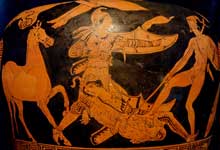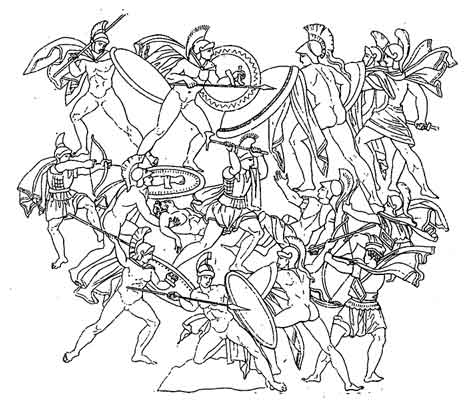
Battle around the body of Patroclus, from a vase painting
In Greek mythology, as recorded in the Iliad by Homer, Patroclus, or Pátroklos (gr. Πάτροκλος "glory of the father") was Achilles' best friend and/or lover, son of Menoetius.
Achilles binding the wounds of his friend Patroclus, the son of Menoetius, from a c. 500 BC kylix cup (now in a Museum in Berlin Germany), Sosias Painter, Patroclos wearing a cap used to make the wearing of the helmet more comfortable. Interior and Side View . Patroclus killed later by Hector
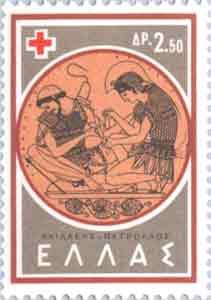
Achilles bandaging Patroclus, pottery with text ΣΟΣΙΑΣ ΕΠΟΙΗΣΕΝ, Sosias made (me), the names of the two heroes being written round the margin. The left upper arm of Patroclus is injured, and Achilles is bandaging it with a two-rolled bandage, which he is trying to bring down to extend over the elbow.Achilles was not a trained surgeon, and it will be observed, from the position of the two tails of the bandage, that he will have some difficulty when it comes to its final fastening! (Charles Singer )
Origins
Menoetius was a member of the Argonauts in his youth. He had made at least four marriages. All four of his wives were identified as the "mother" of Patroclus in different versions. Which one was mother or step-mother seems uncertain:
Periopis was identified as a possible mother of Patroclus by Apollodorus of Athens. She was a daughter of Pheres, founder of Pherae.
Polymele was identified as a possible mother of Patroclus by Apollodorus of Athens. She was a daughter of Peleus, King of Phthia and an older half-sister to Achilles
Sthenele was identified as a possible mother of Patroclus by Apollodorus of Athens. She was a daughter of Acastus and Astydameia.
Philomela was identified as the mother of Patroclus by Gaius Julius Hyginus. Her own origin is not given. She might be related to her namesake daughter of Pandion I, King of Athens and Zeuxippe.
Menoetius was a son of Actor, King of Opus in Locris by Aegina. Aegina was a daughter of Asopus and mother of Aeacus by Zeus. Aeacus was father of Peleus, Telamon and Phocus.
Actor was a son of Deion, King of Phocis and Diomede. His paternal grandparents were Aeolus of Thessaly and Enarete. His maternal grandparents were Xuthus and Creusa, daughther of Erechtheus and Praxithea.
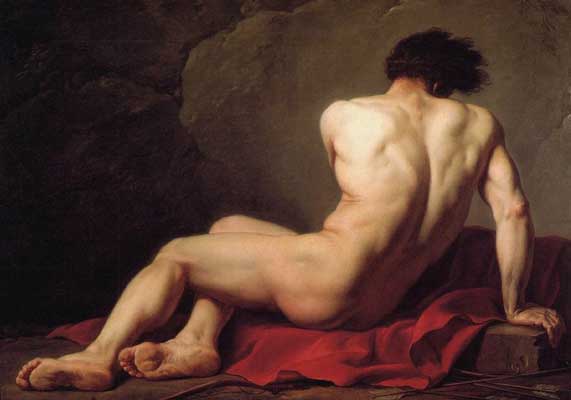
Jacques-Louis David, Patroclus, 1780
Life before the Trojan War
In his youth, Patroclus killed his friend, Clysonymus, during an argument. His father had to escape into exile with Patroclus to escape punishment, and they took shelter at the palace of their kinsman King Peleus of Pthia. There Patroclus apparently first met Peleus' son Achilles. Peleus sent the boys to live in the wilderness and be raised by Chiron, the wise King of the centaurs.
Patroclus was likely somewhat older than Achilles. He is listed among the unsuccesful suitors of Helen of Sparta. Helen instead was given by Tyndareus to Menelaus. All suitors took a most solemn oath to defend the chosen husband against whoever should quarrel with him.
At about that time Patroclus killed Las, founder of a namesake city near Gytheio, Laconia, according to Pausanias the geographer. Pausanias reported that the killing was alternatively attributed to Achilles. However Achilles was not otherwise known to have ever visited Peloponnesos.
Nine years later Helen fled Sparta with Prince Paris of Troy. Menelaus and his brother Agamemnon, King of Mycenae started contemplating war against Troy. The preparations of war and gathering of allies and armies took him ten years according to some versions. But Patroclus was certainly among the men summoned to war. He reportedly offered ten ships of his own. His small force however joined that of his cousin Achilles.
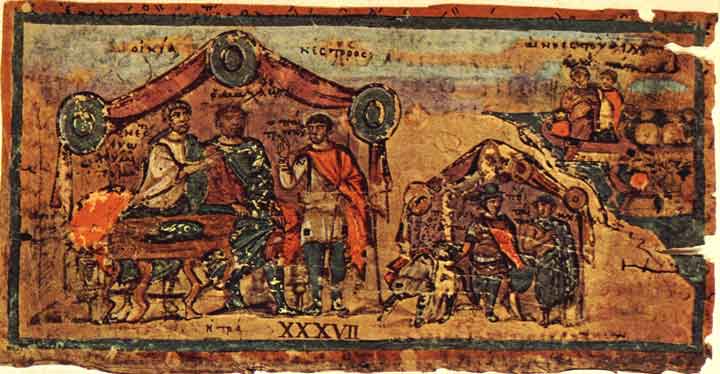
Picture 37 of the Ambrosian Iliad, Nestor and Patroclus.
Trojan War activities
When Achilleus refused to fight because of his feud with Agamemnon, Patroclus donned his armor, led the Myrmidons and killed many Trojans, including Sarpedon (a son of Zeus), Kebriones (the chariot driver of Hector). He was killed by Hector and Euphorbos, with help from Apollo.
After retrieving his body, which had been protected on the field by Menelaus and Telamonian Aias, Achilles returned to battle and avenged his friend's and/or lover's death by killing Hector and desecrated his body behind his chariot instead of allowing the Trojans to honorably dispose of it by burning it. Achilleus' grief was huge and for some time refused to bury Patroclus' body, but he was persuaded to do so by an apparition of Patroclus, who told him he could not enter Hades without a proper cremation. Achilleus cut a lock of his hair and sacrificed horses, dogs, and twelve Trojan captives before placing Patroclus' body on the funeral pyre.
Homer's Iliad inspired this pottery art of the chariot races at Patroclus's funeral games.
Achilles then organized an athletic competition to honour his dead friend and/or lover, which included a chariot race (won by Diomedes), boxing (won by Epeios), wrestling (a draw between Telamonian Aias and Odysseus), a foot race (won by Odysseus), a duel (a draw between Aias and Diomedes), a discus throw (won by Polypoites), an archery contest (won by Meriones), and a javelin throw (won by Agamemnon, unopposed). The games are described in Book 23 of the Iliad, one of the earliest references to Greek sport.
Relationship to Achilles
In the Iliad, the relationship between Patroclus and Achilles is a vital part of the story. The relationship contributes to the overall theme of the humanization of Achilles.
Burial and later reports
The death of Achilles is given in sources others than the Iliad. His body was given a funeral pyre. His bones were mingled with those of Patroclus so that the two would be companions in death as in life.Their remains were tranferred to Leuke island of the Black Sea. Their souls were reportedly seen wandering the island at times.
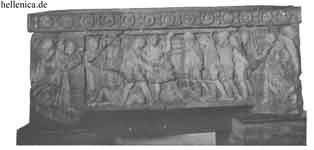
Sacrifice of Trojans at the tomb of Patroclus , Etruscan Sarcophagus
In Homer's Odyssey, Odysseus meets Achilles in Hades, accompanied by Patroclus, Telamonian Ajax and Antilochus.
A general of Croton identified either as Autoleon or Leonymus reportedly visited Leuke while recovering from wounds received in battle against the Locri Epizefiri. The event was placed during or after the 7th century BC. He reported having seen Patroclus in the company of Achilles , Ajax the Lesser, Telamonian Aias, Antilochus and Helen.
Statue of Patroklos, Temple of Hephaistos (Athens)
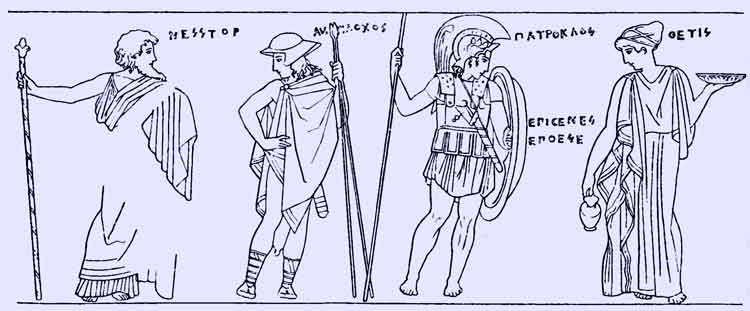
Nestor, Antilochos, Patroclus and Thetis, "Epigenes Epoiese"
Iliad
- Book 16: Patroclus Fights and Dies
- Book 23: The Funeral Games for Patroclus
See also : Greek Mythology. Paintings, Drawings
Retrieved from "http://en.wikipedia.org/"
All text is available under the terms of the GNU Free Documentation License
| Ancient Greece
Science, Technology , Medicine , Warfare, , Biographies , Life , Cities/Places/Maps , Arts , Literature , Philosophy ,Olympics, Mythology , History , Images Medieval Greece / Byzantine Empire Science, Technology, Arts, , Warfare , Literature, Biographies, Icons, History Modern Greece Cities, Islands, Regions, Fauna/Flora ,Biographies , History , Warfare, Science/Technology, Literature, Music , Arts , Film/Actors , Sport , Fashion --- |

